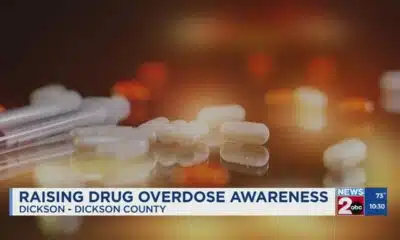News from the South - West Virginia News Feed
Experts urge caution, focus on proven interventions as WV celebrates decrease in fatal overdoses
by Caity Coyne, West Virginia Watch
July 11, 2025
As West Virginia records the largest reduction in fatal overdoses across the nation over a 12 month period, substance use disorder experts are urging caution and encouraging the state to continue, while also increasing, the services available to people who use drugs.
According to data from the Centers for Disease Control and Prevention, West Virginia has seen two months of declines in the annual rate of fatal overdoses, representing a 41% decrease compared to deaths reported in both preceding 12 month periods.
The drop is decidedly good news for the state, which has for years been referred to as “ground zero” for the nation’s ongoing drug and overdose epidemic.
But even while celebrating, experts say it’s important to ensure the context and circumstances surrounding the decline is taken into account.
“Two months is not a lot of time,” said Michael Meit, director of the Center for Rural Health and Research at East Tennessee State University. “You need to make sure that trend continues and, if it does — which we all hope it will — that’s when you’ll know that the systems in place are working in a positive way.”
The data from the CDC represents overdose deaths recorded between January 2024 and January 2025, the most recent data available for analysis by the agency. The numbers are provisional and could increase as more deaths are analyzed.
According to the data, West Virginia so far has confirmed 787 deaths in that 12 month period. Between January 2023 and 2024, per the data, the state saw 1,351 residents die from overdoses.
Meit, who is also an associate professor in ETSU’s Department of Health Services Management and Policy, said there are several factors that could contribute to the state successfully curbing fatal overdose rates. Crucial context for the decline, he said, is how rates of both substance use and fatal overdoses related to that use increased so much during the pandemic.
In 2020, 1,343 West Virginians died from fatal overdoses — setting a new record for the state. In 2021, deaths increased again to 1,537, according to data from the state health department. The trend in the state reflected what was happening nationally; overdoses — fatal and otherwise — increased nearly everywhere while the COVID-19 pandemic unfolded.
In 2022, 2023 and 2024, overdose deaths in West Virginia dropped consecutively each year, per the data.
Now, Meit said, it’s likely conditions are evening out. The record decline could, at least in part, reflect this.
“Two months is not a lot of time. You need to make sure that trend continues and, if it does — which we all hope it will — that’s when you’ll know that the systems in place are working in a positive way.”
– Michael Meit, director of the Center for Rural Health and Research at East Tennessee State University
“I hope we’re turning a curve, but I’m a little bit of a skeptic at heart. West Virginia leading the nation [in the decline] implies that West Virginia is doing better than other places in addressing these issues. So I do think that it’s not just a blip, but there are other things to consider,” Meit said. “I am concerned that a lot of the declining overdose rates that we are seeing now — a partial factor is what we call a return to baseline. So we are essentially getting back to where we were pre-pandemic.”
The fatalities reported between January 2024 and 2025 are the lowest recorded in the state since 2015, when 735 people died from overdoses. At the time, that was the highest number reported by West Virginia in one year since 2001, when the state started tracking and reporting overdose deaths.
Dr. James Berry, who serves as chair for the Department of Behavioral Medicine and Psychiatry at West Virginia University’s Rockefeller Neuroscience Institute, said he was “encouraged” to see declines in the state. But like Meit, he’s cautious about assuming the declines will continue without further work, especially given where West Virginia still stands nationally.
“This decline means so many more lives will continue to exist because of efforts that have been going on in the state. At the same time, in West Virginia, we still lead the nation by far in the rates of overdose deaths,” Berry said. “We’ve had a wonderful decline, but still I don’t think people appreciate how far above we are other states [in the rate of fatal overdoses], above the national average. So we still have a very, very long way to go.”
‘We have to keep our foot on the pedal’
Gov. Patrick Morrisey celebrated the state’s decline in overdose deaths during a news conference in Princeton on Wednesday. In a release after, he said the state is “setting the standard for successfully battling addiction and saving lives.”
“Our nation-leading reduction in overdose deaths is the result of a holistic approach to tackle drug use and abuse,” Morrisey said. “We will continue to work hard together to prevent further senseless death in West Virginia.”
Meit has spent a lot of time researching what factors and policies, specifically, lead communities to decreasing or increasing their overdose rates.
One of his studies honed in on eastern Kentucky, a region both culturally and economically reminiscent of West Virginia’s southern coalfields.
West Virginia’s coalfield counties continuously lead the state — as well as the nation — in the rate of fatal overdoses. Not long ago, the counties in eastern Kentucky did the same.
But something happened in the 2010s that turned the tide in Kentucky.
Between 2012 and 2017, eight of the top 10 counties in the nation with the steepest decrease in overdose mortality were clustered in eastern Kentucky.
“What we found was a big investment in addressing the substance use crisis — in establishing harm reduction programs throughout the state, making sure they had treatment beds available, paying for treatment, engaging their criminal justice system,” Meit said. “These declines were studied over a 10 year period before the pandemic; we know it wasn’t just a blip — it was a direct response to the systems in place.”
Kentucky today, Meit said, has the most harm reduction sites of any state in the country. Most offer syringe service programs. The state also has the highest number of residential treatment beds and its Medicaid program includes a dedicated benefit for receiving substance use disorder treatment.
The environment in West Virginia, however, is much different.
Harm reduction programs are few and far between. Needs-based syringe service programs — which are the most effective at preventing disease among people who use drugs as well as transitioning people into recovery — are banned at the state level. There’s a shortage of treatment beds, especially in the regions hardest hit by the drug epidemic. There’s been a moratorium on establishing new methadone clinics in the state for years, meaning the medication — proven to be incredibly effective at helping people overcome opioid use disorder — isn’t available to most.
The current recovery and rehabilitation environment in West Virginia can largely be attributed to policies adopted by the state Legislature over the last decade. In the last several years, very few laws have been enacted by the body that reflect “best practices” for addiction and recovery; instead lawmakers have mostly focused on the criminalization of substance use disorder and the people who live with it.
Berry has worked in West Virginia studying and treating substance use disorder since 2002. He’s watched firsthand as the nature of the epidemic has shifted from prescription drug use to heroin use to, most recently, fentanyl. Each time, as new drugs have come into communities, overdoses have increased alongside increased use.
Berry has also watched how policies have evolved — or, in several ways, devolved — in response to the changes in the nature of the epidemic.
It’s likely, Berry said, that the decreases being celebrated this month in West Virginia reflect “the bearing of fruit that were the labors put in place, five to 10 years ago.”
Those “labors” include expanded access to naloxone, efforts to destigmatize addiction, recruiting health care workers with specific expertise on substance use disorder, increasing access to treatment programs as well as beds and an emphasis on educating both the public and providers about the disease.
Berry is slightly concerned that the successes being celebrated this month could mean a decreased focus by lawmakers on interventions that are working. To step back now, he said, would threaten future success.
“It’s so encouraging that we’ve got some traction. After so many years of going in the wrong direction, we finally have some traction but we have to keep our foot on the pedal and keep going forward,” Berry said. “If we don’t do that, if we don’t keep looking at what more we can do, then I really fear that we’re going to start getting worse again.”
YOU MAKE OUR WORK POSSIBLE.
West Virginia Watch is part of States Newsroom, a nonprofit news network supported by grants and a coalition of donors as a 501c(3) public charity. West Virginia Watch maintains editorial independence. Contact Editor Leann Ray for questions: info@westvirginiawatch.com.
The post Experts urge caution, focus on proven interventions as WV celebrates decrease in fatal overdoses appeared first on westvirginiawatch.com
Note: The following A.I. based commentary is not part of the original article, reproduced above, but is offered in the hopes that it will promote greater media literacy and critical thinking, by making any potential bias more visible to the reader –Staff Editor.
Political Bias Rating: Centrist
This article provides a factual report on West Virginia’s reduction in overdose deaths, highlighting data from reputable sources like the CDC and expert commentary without apparent ideological framing. It balances recognition of progress with cautious expert opinions urging sustained efforts, reflecting a pragmatic tone. The coverage includes criticism of state policies limiting harm reduction programs while acknowledging the successes of past interventions, presenting multiple perspectives without partisan language. Overall, it maintains a neutral stance focused on public health outcomes rather than promoting a specific political viewpoint or agenda.
News from the South - West Virginia News Feed
Veteran outreach returns to Oak Hill
SUMMARY: Veteran outreach services have returned to Oak Hill after a brief pause caused by the retirement of coordinator James Willis. The mobile vet center visits the Oak Hill Church of the Nazarene monthly to assist veterans, but now operates through volunteers without the mobile van. Veteran Tom Tanner, determined to continue support, secured resources from the vet center and arranged monthly meetings, offering services and camaraderie. The program focuses especially on Vietnam-era vets unfamiliar with benefits processes. Events include hot dogs, barbecues, and a welcoming atmosphere fostering unity among veterans. All veterans are encouraged to attend for help or fellowship.
FOLLOW US ON FACEBOOK AND TWITTER: https://facebook.com/WOAYNewsWatch https://twitter.com/WOAYNewsWatch.
News from the South - West Virginia News Feed
Rural Health Transformation Program is woefully inadequate to save West Virginia hospitals
by Ellen Allen, West Virginia Watch
August 28, 2025
As I visit communities around my beloved West Virginia to talk about the impacts and consequences of Capito Care, or HR 1, perhaps the most sweeping and arguably the worst piece of health care legislation to ever come out of our nation’s capital, it is the impact upon rural hospitals that is getting the most attention — and concern.
If you have attended one of the meetings or town halls where I have discussed the dire consequences of the $1.1 trillion in cuts to Medicaid, then you have also heard me discuss the vulnerability of our hospitals. Quite frankly, there is not a single hospital in our state that will not be affected. However, there are 10 hospitals and three nursing homes in our state that are either at high risk for closure or vulnerable to closure. You can find those hospitals and the supporting analysis in Rural Hospital Closures — Sheps Center at UNC Chapel Hill and Federal Medicaid Cuts Would Force Rural Hospitals to the Brink of Closure by Families USA, a national, non-partisan advocate for health care consumers.
These hospitals are not in imminent danger of closure. They will, however, be in danger starting in 2027 as the provider tax, the funding mechanism that helps fund Medicaid, is rolled back and ultimately dismantled.
The $50 billion Rural Health Transformation Program is touted as the solution to saving rural hospitals from the dismantling of the funding mechanism for Medicaid. Perhaps it is better than not having one, but barely. It was a last minute addition to appease the outcry of hospital administrators around the country who foresaw the existential threat of Medicaid cuts to their hospitals.
Here is why the fund is inadequate to meet the moment:
- According to the Congressional Budget Office, the fund will roughly offset only 37% of estimated cuts to Medicaid spending. States will have to make up the difference.
- Half of the funds — $25 billion — will be equally distributed among the states with approved applications (states must apply for these funds) irrespective of the rural population or financial health of the rural hospitals. This approach may not adequately address unique challenges faced by hospitals in states with large rural populations, or greater need of older or sicker populations. This certainly stands out to me as a red flag for West Virginia.
- The $50 billion fund may not be enough to overcome systemic issues, of which West Virginia has many. These include rural hospitals who have been operating on razor thin margins for years, or even negative revenue, declining patient volumes, and workforce shortages.
- West Virginia hospitals serve an older, sicker and poorer population. It is just a fact. Many of our hospitals rely heavily on government payers such as Medicaid and Medicare which reimburse at below cost of providing services.
To add insult to this injury, these funds may not even go to rural hospitals. There is no guarantee. The law says that states should use the funds to pursue goals including improving access to hospitals and other providers, improving health outcomes, enhancing economic opportunity for health care workers, and prioritizing the use of emerging technologies. All good things worthy of funding.
Dr. Mehmet Oz, a President Donald Trump appointee leading Medicare and Medicaid, will determine how to distribute the other $25 billion. The law says the money is to be used for such things as increasing robotics, upgrading cybersecurity and helping rural communities “to right size their health care delivery systems.”
And here is the real kicker, especially given the carrot and stick approach of the Trump administration: The law not only grants the Center for Medicare and Medicaid Services broad discretion over the award and distribution of funds, but these funding decisions are not subject to administrative or judicial review.
What could possibly go wrong? Capito Care is bad policy and it is not ameliorated by a mere $50 billion fund. We urge hospitals and supporting associations to fight for adequate funding to protect health care in their communities.
If these rural hospitals close — and some will —we may never get them back.
Sen. Shelley Moore Capito should revise Capito Care while there is still time, and turn it into legislation she would be proud of. Sen. Jim Justice and Reps. Carol Miller and Riley Moore should join her.
GET THE MORNING HEADLINES.
West Virginia Watch is part of States Newsroom, a nonprofit news network supported by grants and a coalition of donors as a 501c(3) public charity. West Virginia Watch maintains editorial independence. Contact Editor Leann Ray for questions: info@westvirginiawatch.com.
The post Rural Health Transformation Program is woefully inadequate to save West Virginia hospitals appeared first on westvirginiawatch.com
Note: The following A.I. based commentary is not part of the original article, reproduced above, but is offered in the hopes that it will promote greater media literacy and critical thinking, by making any potential bias more visible to the reader –Staff Editor.
Political Bias Rating: Center-Left
This content critiques a Republican-led healthcare proposal, highlighting concerns about Medicaid cuts and their impact on rural hospitals, particularly in West Virginia. It emphasizes the negative consequences of the legislation and calls for revisions from Republican lawmakers, reflecting a perspective that favors stronger government support for healthcare funding. The tone and focus suggest a center-left bias, advocating for more robust public healthcare investment and protections for vulnerable communities.
News from the South - West Virginia News Feed
The Scott Skyhawks look to soar during Jeremy Dolin’s final year as head coach
SUMMARY: The Scott Skyhawks, led by head coach Jeremy Dolan in his final season, aim to continue their football success in 2025. After reaching the second round of postseason play last year, the team faces a rebuilding year, having lost 12 seniors and five All-State players. Despite this, Dolan is confident in returning talent like their second-team All-State quarterback, Mason Brown, and key players Ethan Bo, Thomas Chris, Caden Sharps, and Brian Neal. With a strong senior and incoming freshman class, the Skyhawks are ready to compete with heart and physicality, striving for postseason success in Dolan’s last year coaching.
The Scott Skyhawks reached the second round of the postseason a year ago before bowing out to Roane County. It’s a case of doing some reloading as the 2025 season looms.
FULL STORY: https://wchstv.com/sports/top-sports/countdown-to-kickoff-edition-42-skyhawks-want-to-soar-during-dolins-last-year-as-coach
_________________________________________
For the latest local and national news, visit our website: https://wchstv.com/
Sign up for our newsletter: https://wchstv.com/sign-up
Follow WCHS-TV on social media:
Facebook: https://www.facebook.com/eyewitnessnewscharleston/
Twitter: https://twitter.com/wchs8fox11
Instagram: https://www.instagram.com/wchs8fox11/
-
News from the South - Texas News Feed5 days ago
Racism Wrapped in Rural Warmth
-
News from the South - Missouri News Feed6 days ago
Donors to private school voucher program removed from Missouri transparency site
-
News from the South - Alabama News Feed6 days ago
Child in north Alabama has measles, says Alabama Department of Public Health
-
News from the South - Texas News Feed6 days ago
Texas Democrats’ walkout prompts GOP retribution
-
News from the South - Missouri News Feed6 days ago
New Missouri law means state is no longer allowed to seize assets of prison inmates
-
News from the South - Tennessee News Feed6 days ago
A marsh bird found in Tennessee wetlands is endangered. FWS is drafting a plan.
-
News from the South - Alabama News Feed7 days ago
Wilsonville residents seek preemptive strike against massive data center project
-
News from the South - Georgia News Feed6 days ago
Voters head to the polls to pick new metro Atlanta state senator in low-turnout special election












































